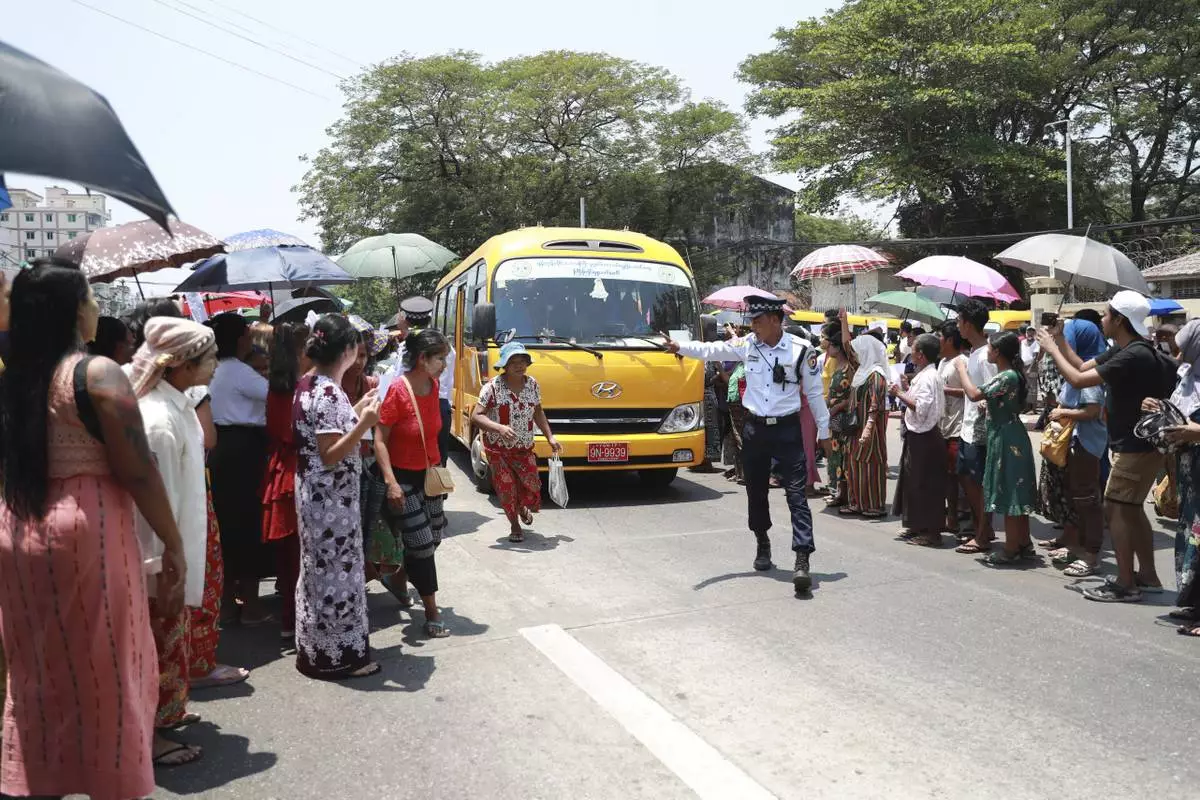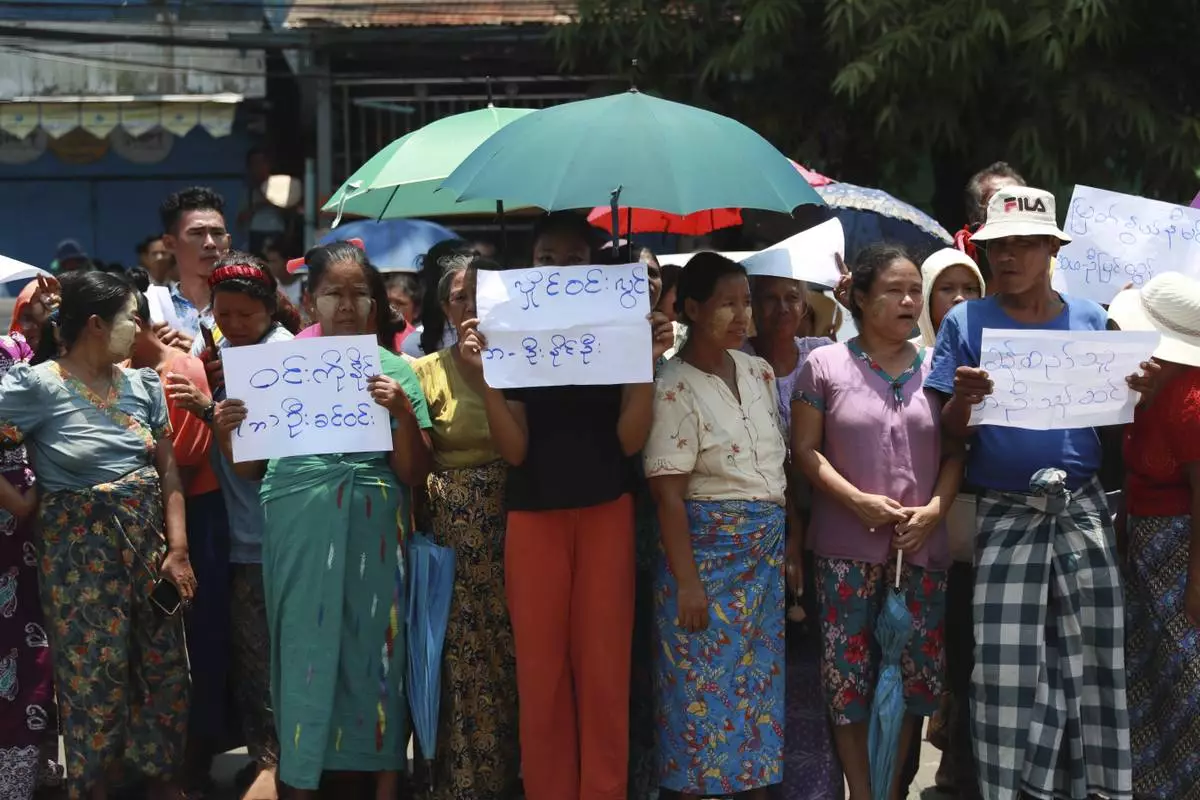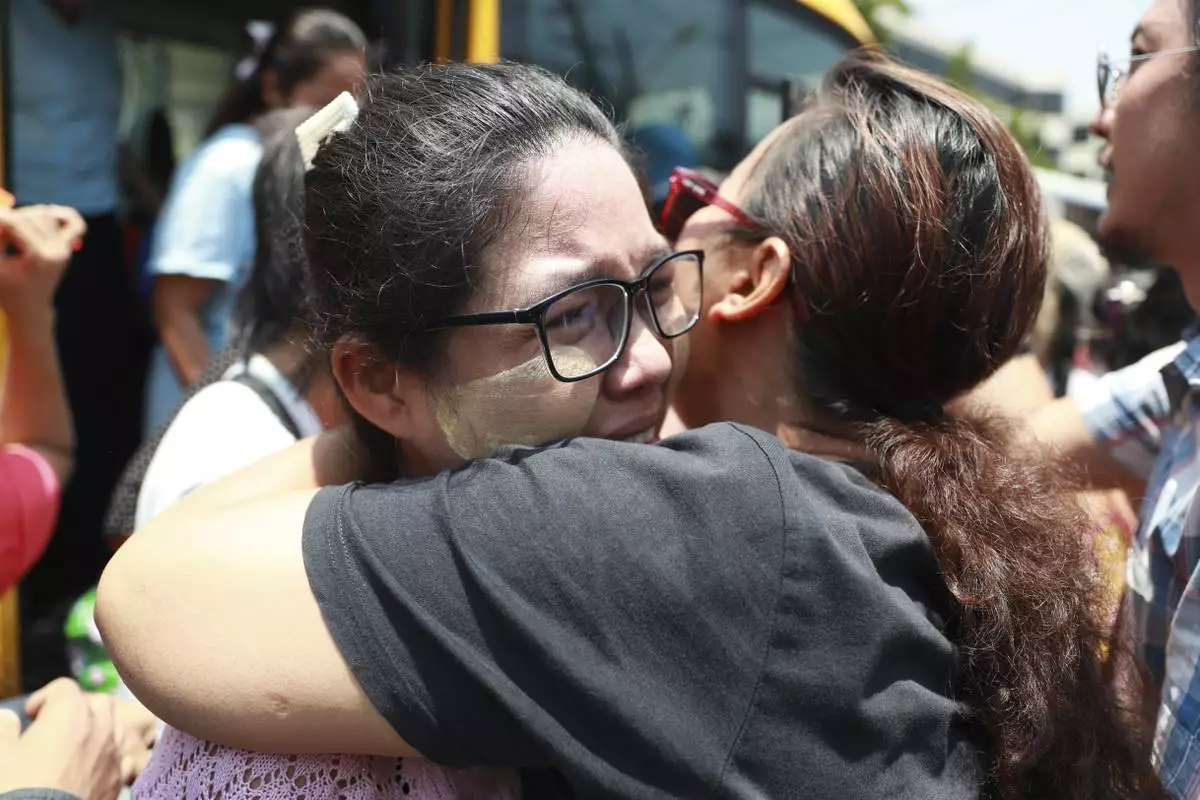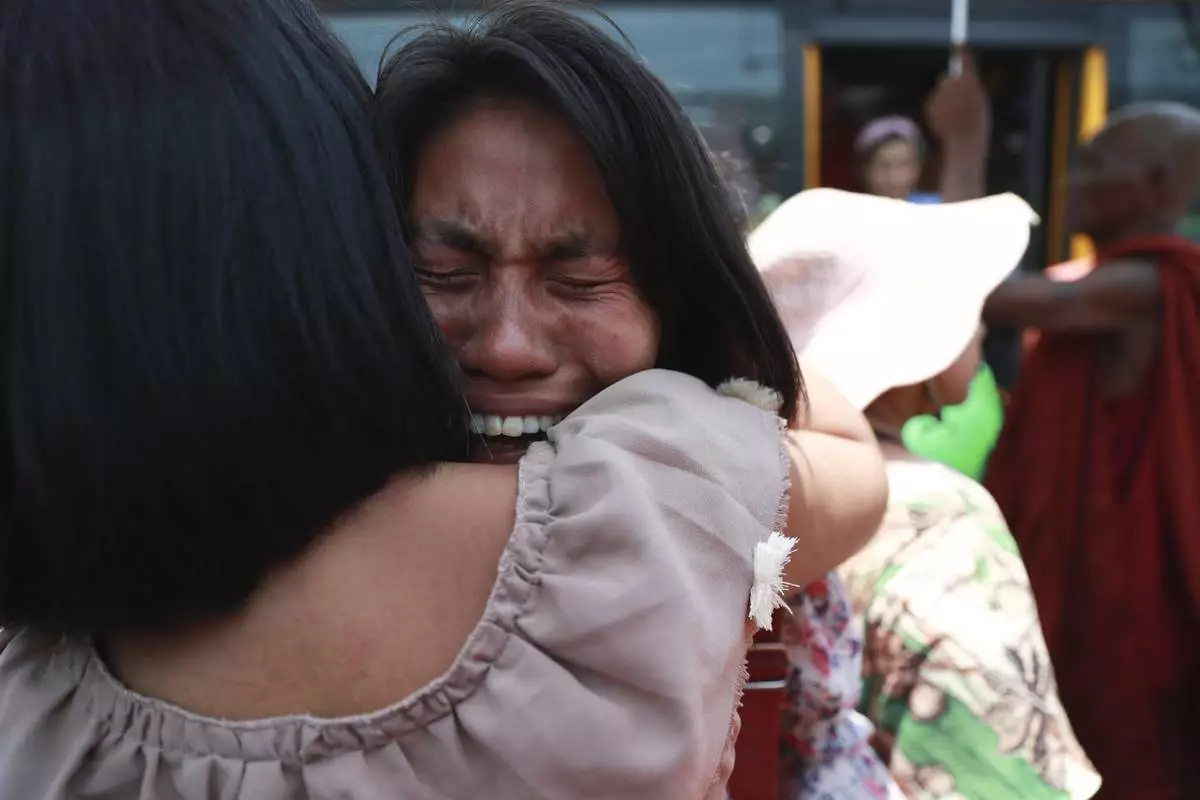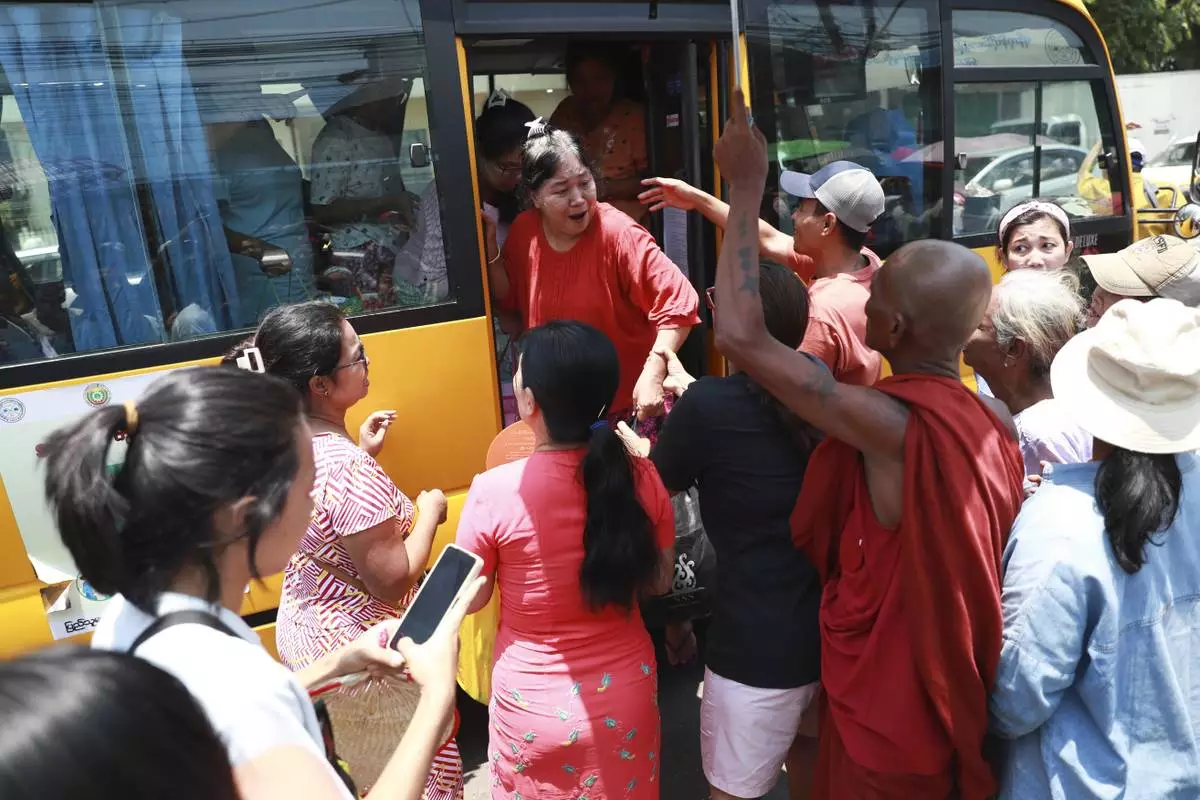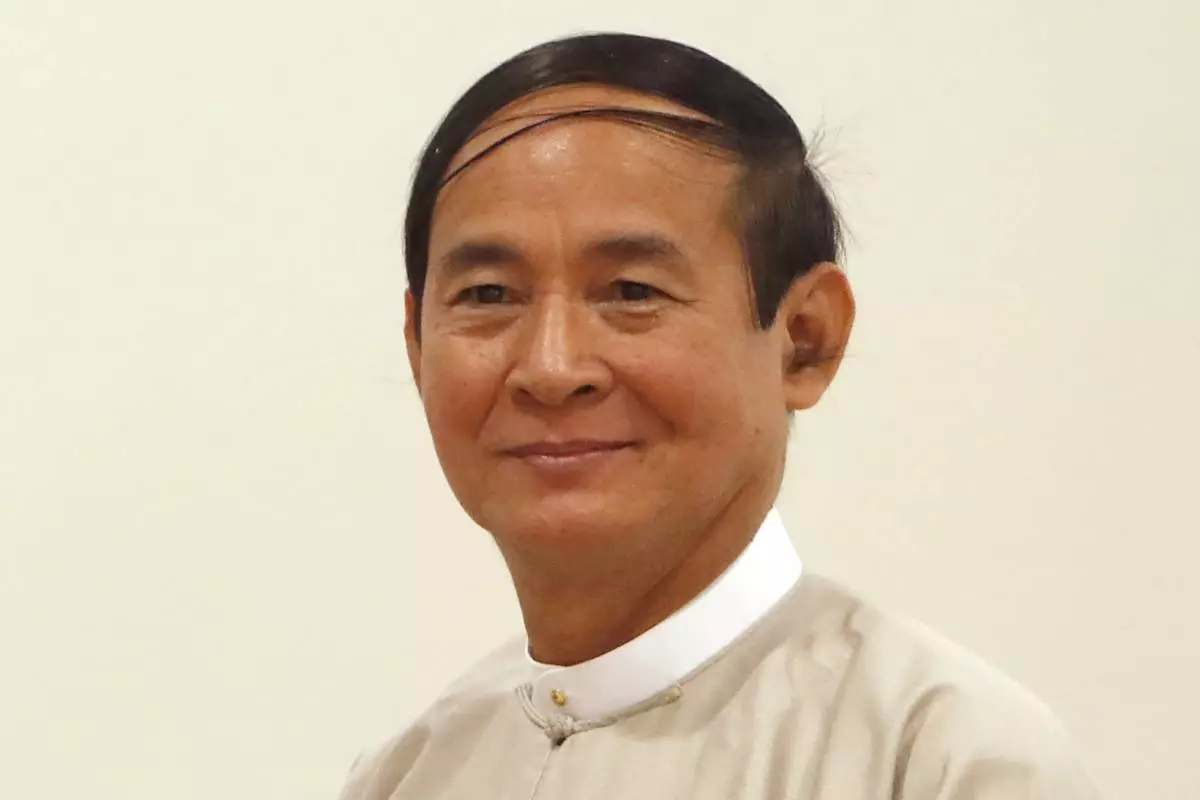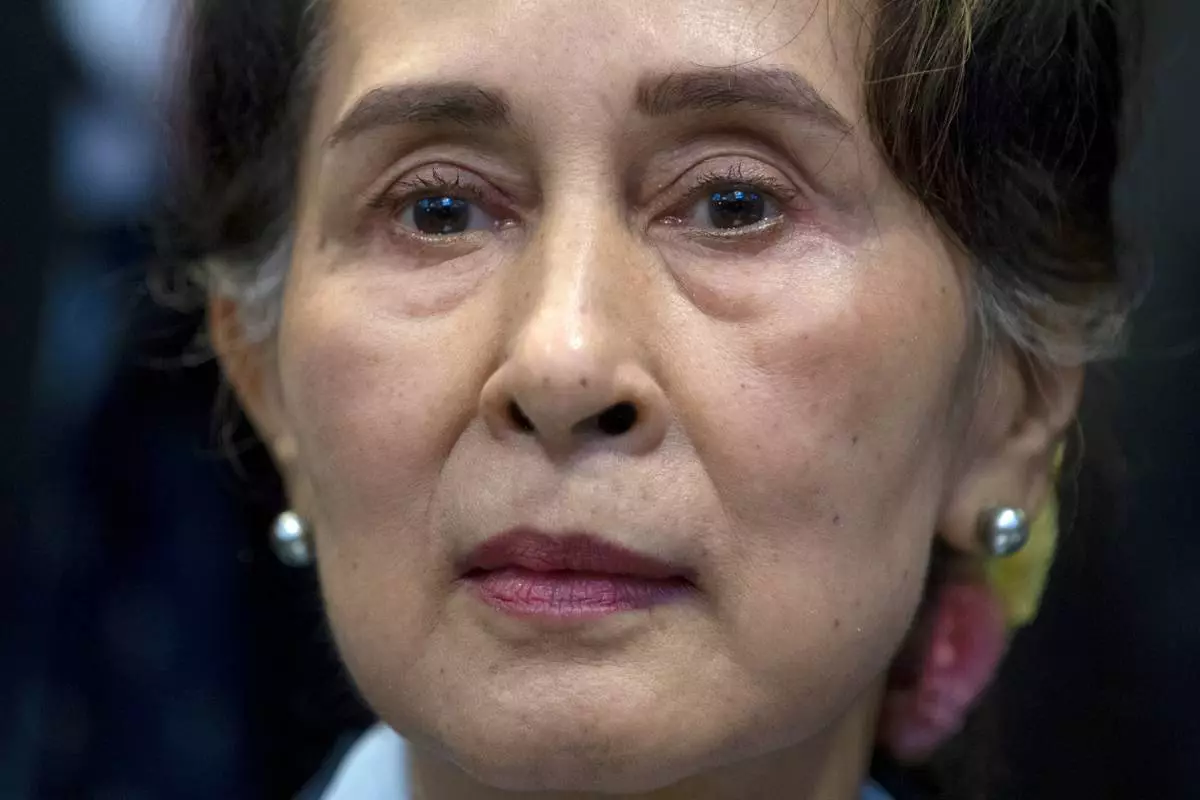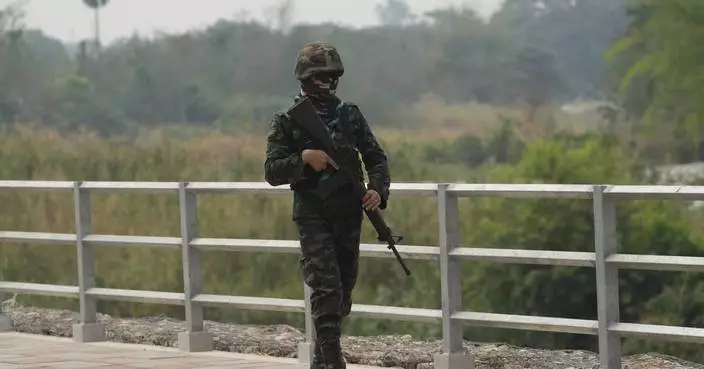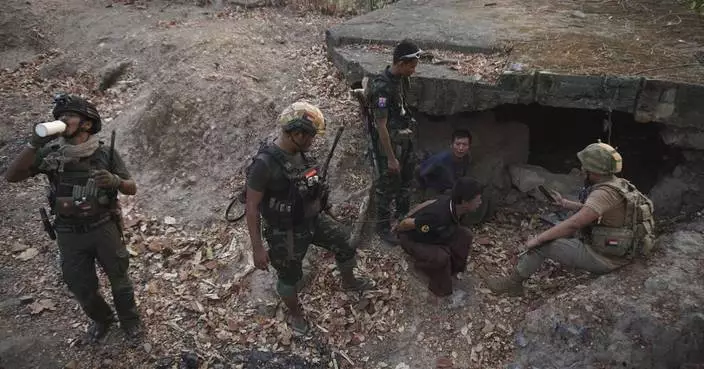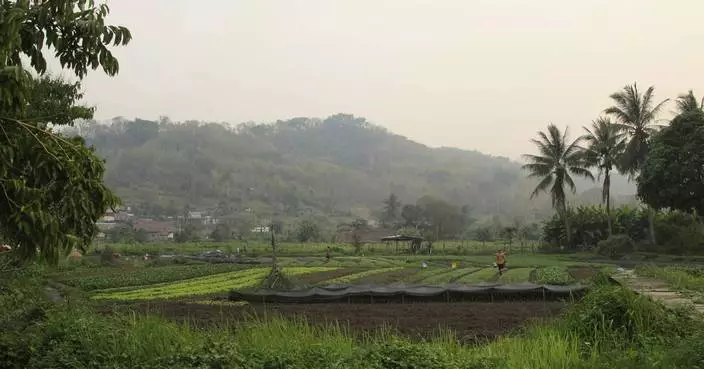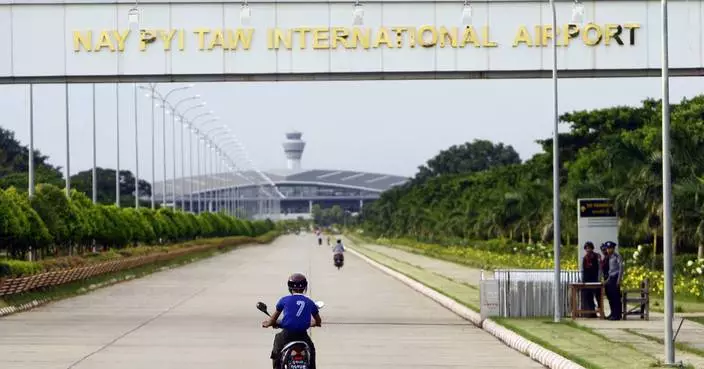Across the ferocious waves and the churning black water, Alam Jafar could see his frantic 7-year-old son gasping for breath, his arms flailing just above the ocean's surface.
It was raining, and a fierce monsoon storm had transformed the sky and the sea into a kaleidoscope of gray shadows that was impossible to escape. The little boy was crying out louder than he ever had in his life. He did not know how to swim.
"Papa! Papa! Help Me!"
"Papaaaaa."
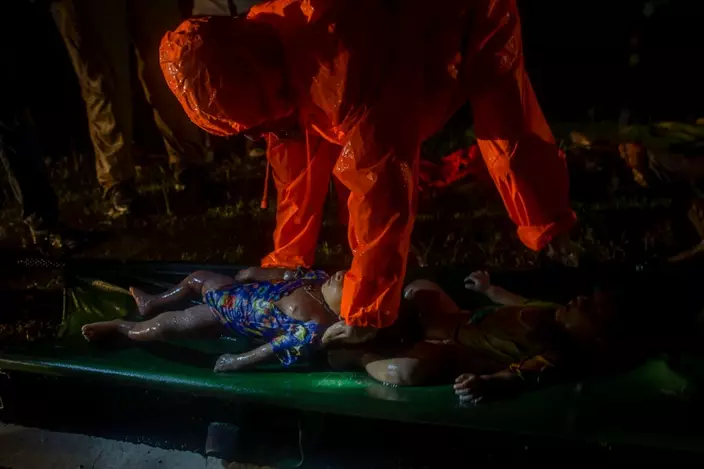
In this Sept. 28, 2017 file photo, a rescue worker places the body of a Rohingya Muslim boy, who died after their boat capsized in the Bay of Bengal as they were crossing over from Myanmar into Bangladesh, onto a stretcher near Inani beach, in Cox's Bazar district, Bangladesh. Of the 80 refugees believed to have been on the boat, only 24 are known to have survived. Police collected 23 corpses from the shore. The rest, mostly children, are missing and presumed to have drowned. They were part of the largest human exodus in Asia since the Vietnam War, a colossal tide of more than 500,000 Rohingya Muslims whose homes had been torched by Buddhist mobs and soldiers. (AP Photo/Dar Yasin, File)
Just moments before, they had huddled together in the relative safety of a small fishing boat filled with refugees from Myanmar that was bound for Bangladesh. They were part of the largest human exodus in Asia since the Vietnam War — a colossal tide of more than 500,000 Rohingya Muslims whose homes had been torched by Buddhist mobs and soldiers.
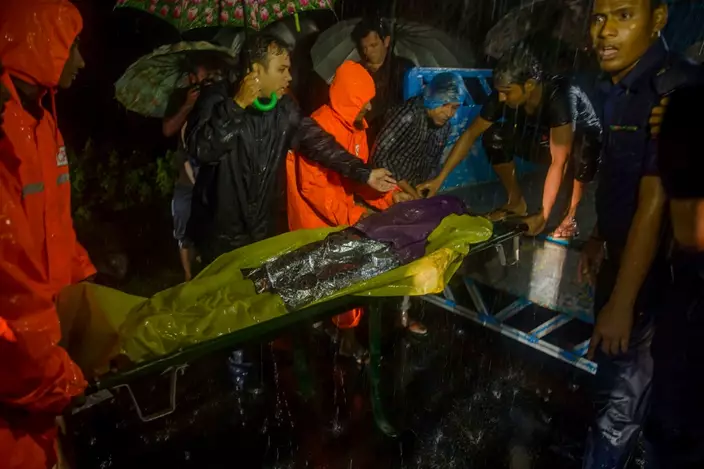
In this Sept. 28, 2017 file photo, policemen and rescue workers carry the body of a Rohingya Muslim, who died after their boat capsized in the Bay of Bengal as they were crossing over from Myanmar into Bangladesh, near Inani beach, in Cox's Bazar district, Bangladesh. Of the 80 refugees believed to have been on the boat, only 24 are known to have survived. Police collected 23 corpses from the shore. The rest, mostly children, are missing and presumed to have drowned. They were part of the largest human exodus in Asia since the Vietnam War, a colossal tide of more than 500,000 Rohingya Muslims whose homes had been torched by Buddhist mobs and soldiers. (AP Photo/Dar Yasin, File)
What happened next, just 1,000 feet (300 meters) from shore, would take the lives of at least 50 people, most of them children, in the deadliest tragedy of its kind since the crisis exploded in late August. Through interviews with more than a dozen survivors, The Associated Press has reconstructed their ill-fated journey late last month — an odyssey that underscores the perils faced by all those who flee.
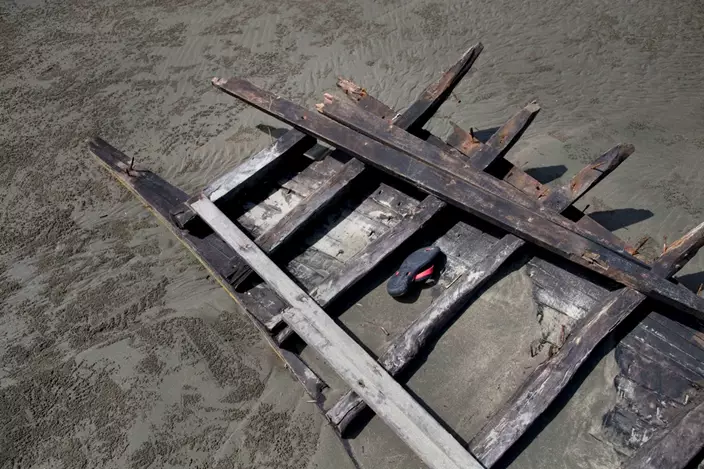
This Oct. 30, 2017, photo shows a portion of a small fishing boat that capsized while it was bound for Bangladesh, filled with Rohingya refugees from Myanmar on Sept. 28, 2017, on Inani beach in Cox's bazar, Bangladesh. The boat capsized just 1,000 feet (300 meters) from shore, taking the lives of at least 50 people, most of them children, in the deadliest tragedy of its kind since the crisis exploded in late August. They were part of the largest human exodus in Asia since the Vietnam War, a colossal tide of more than 500,000 Rohingya Muslims whose homes had been torched by Buddhist mobs and soldiers. (AP Photo/Gemunu Amarasinghe)
For Jafar, the most haunting part was not when the wave "as big as a mountain" swallowed everything in the blink of an eye.
It was the moment after, when he surfaced in shock vomiting saltwater, and heard the cries of the people who had been hurled into the dark mouth of the sea.
His wife of eight years and their newborn twins were among them.
So, too, was his beloved son.
"Papa! Papa! Help Me!"
"Papaaaaa."
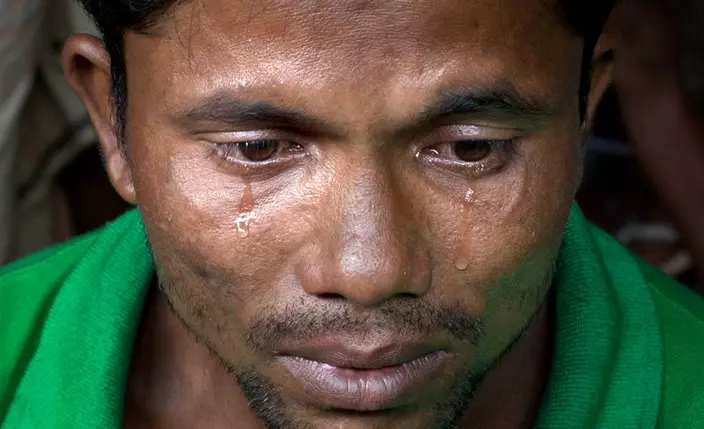
In this Sept. 30, 2017, photo tears roll down the cheeks of Rohingya man Alam Jafar as he recounts the story of his journey from Myanmar to Bangladesh, at a transit shelter at Kutupalong camp for newly arrived Rohingya refugees in Bangladesh. In Myanmar, the 25-year-old farmer owned a verdant rice field, a boat that ferried passengers up and down the river and lived in a four-room house made of wood and bamboo surrounded by coconut and mango trees. When the mob came to his village on Sept. 25, Jafar had no choice but to flee with his wife and three children. The boat they were traveling on capsized on Sept. 28 and left him as the sole survivor in a family of 5. (AP Photo/Gemunu Amarasinghe)
Short and stocky with a fiery temper, Jafar grew up in a small village in northwestern Myanmar called Moidaung.
It was a quiet place of immense beauty: Emerald rice fields. Lush mountains. A river that snaked through the land. For the Rohingya Muslims, though, it was also a prison — they could not travel without consent from authorities.
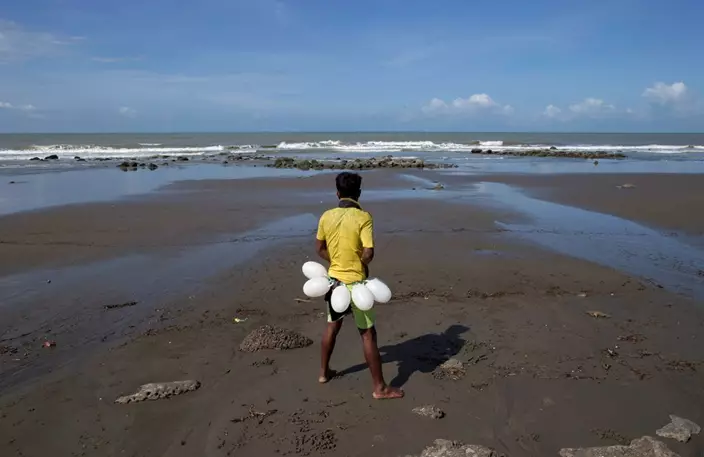
In this Oct. 30, 2017 photo a fisherman adjusts his waist floats near the site where a boat carrying Rohingya refugees capsized on Sept. 28 at Inani beach, Cox's Bazar, Bangladesh. The boat capsized just 1,000 feet (300 meters) from shore, taking the lives of at least 50 people, most of them children, in the deadliest tragedy of its kind since the crisis exploded in late August. They were part of the largest human exodus in Asia since the Vietnam War, a colossal tide of more than 500,000 Rohingya Muslims whose homes had been torched by Buddhist mobs and soldiers. (AP Photo/Gemunu Amarasinghe)
Although the Rohingya had lived in Myanmar for generations, the country's Buddhist majority still considered them invaders from Bangladesh. The government denied them basic rights, and the United Nations called them the most persecuted minority in the world.
Despite their plight, Jafar had managed to do well for himself. The 25-year-old farmer lived in a four-room house surrounded by coconut and mango trees. He owned a verdant rice field and a boat.
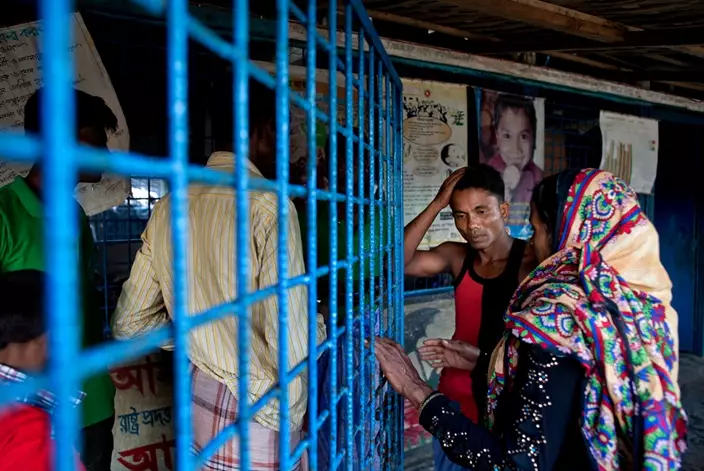
In this Oct. 1, 2017, photo Rohingya man Alam Jafar, second right, stands with other Rohingya refugees at a transit shelter at Kutupalong camp for newly arrived Rohingya refugees in Bangladesh. In Myanmar, the 25-year-old farmer owned a verdant rice field, a boat that ferried passengers up and down the river and lived in a four-room house made of wood and bamboo surrounded by coconut and mango trees. When the mob came to his village on Sept. 25, Jafar had no choice but to flee with his wife and three children. On Sept. 28, the small fishing boat they were traveling in capsized while it was bound for Bangladesh and left him as the sole survivor of the family of 5. (AP Photo/Gemunu Amarasinghe)
In 2009, he married the love of his life, Tayiba Khatun, after saving enough to pay her dowry in gold: a necklace, a pair of earrings, and a small nose-ring. A year later, they had a son, Mohamed Zobair, an energetic boy who loved soccer and school.
Mohamed learned to read not only Burmese, but English as well, and Jafar could not resist spoiling him. He bought whatever the boy wanted every time they went to the market.
In July, Khatun gave birth to twins, a boy named Yasin and a girl, Noor Khaida. But the happiness was short-lived.
About a month later, Rohingya insurgents attacked dozens of police posts and an army base. In response, mobs backed by security forces began setting entire Rohingya villages ablaze.
Word came to Moidaung of children shot and women raped. Too afraid even to venture into their fields, the Rohingya in Moidaung cowered in their homes.
When ethnic Rakhine Buddhists began marching into the village with sharpened bamboo sticks and machetes, escorted by soldiers, Jafar and his wife watched from a window in their home.
"This is Buddhist land!" the men shouted. "It does not belong to you!
"Get out! Get out!"
Two days later, just before dawn on Sept. 25, the mobs came back.
Woken by the crackle of gunfire and screams in the distance, Jafar looked outside and saw flames and smoke rising on the far end of Moidaung. Whole families had already begun fleeing on foot, carrying everything they could in huge plastic sacks.
"How can we just leave everything behind?" Khatun asked.
Jafar tried to console her, wiping the tears from her cheeks.
"We have no choice," he whispered. "We can't stay here. Our belongings are not going to save our lives."
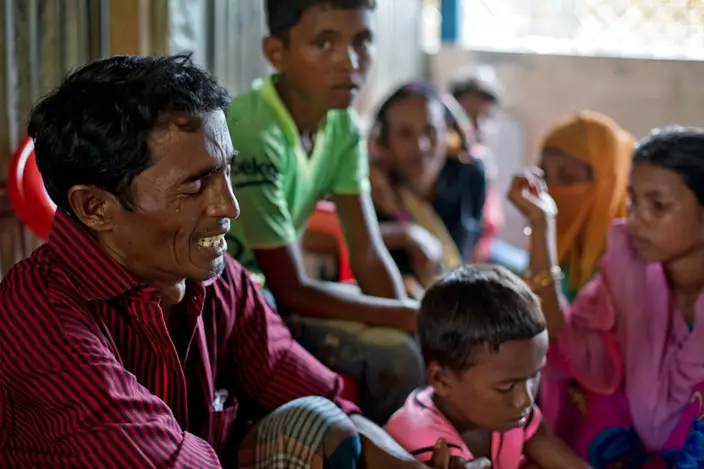
In this Oct. 1, 2017, photo, forty-year old Mohammad Kasim, from Moidaung Village in Myanmar, weeps at a transit shelter at Kutupalong camp for newly arrived Rohingya refugees in Bangladesh. Kasim's wife and two daughters drowned when the fishing boat they were traveling in capsized on Sept. 28, 2017. The boat capsized just 1,000 feet (300 meters) from shore, taking the lives of at least 50 people, most of them children, in the deadliest tragedy of its kind since the crisis exploded in late August. (AP Photo/Gemunu Amarasinghe)
The road leading out of the village was overflowing with an endless stream of families — hysterical parents carrying children, exhausted children hauling babies on their backs.
Jafar's family joined them, and word soon passed down the line. There was a beach where refugees were boarding boats for Bangladesh. To get there, they would have to cross the forested spine of the Mayu mountains.
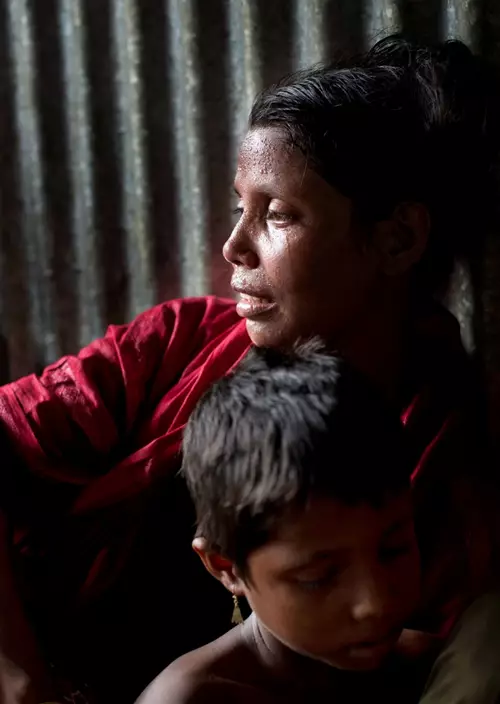
In this Oct. 1, 2017, photo, a Rohingya Muslim woman Malika, mourns as she is reunited with her daughter Nur Kaisha, foreground, and others who survived a boat capsize on Sept. 28, at Kutupalong camp for newly arrived Rohingya refugees in Bangladesh. Of the 80 refugees believed to have been on the fishing boat, carrying Rohingya refugees fleeing Myanmar, only 24 are known to have survived. Three of her children, aged six-months to six-years, drowned in the accident. (AP Photo/Gemunu Amarasinghe)
The pathway up was slippery from the monsoon rains, and they moved slowly, grabbing onto saplings jutting out of the ground. Many of the refugees were barefoot, including Jafar's eldest son, Mohamed.
Wearing only a cheap pair of flip-flops, Jafar struggled to carry the twins, who were cradled in a pair of sacks that hung on opposite sides of a stick across his shoulders.
His wife carried another sack filled with children's clothes, food and a mosquito net. Inside it was all their gold, the deed to their property, and all their savings — about $225.
Fifteen minutes into the forest, they began to smell something nauseating.
Jafar's brother, Sona Mia, saw the bodies first.
The bloated corpse of a man with a wide gash in his throat lay staring up at the sky. A few meters (yards) further on, another dead man was curled on the ground, white foam bubbling from his mouth.
It was unclear who they were, or who killed them. Mia counted seven in all.
"Nobody stopped," Mia said. "Nobody said a word. We couldn't. We just kept going."
Far behind them, on the edge of the forest, a volley of gunshots rang out.
They hiked for two days, scooping cold water from streams and sleeping on the ground. After reaching the bottom of the mountain, the greenery gave way to roads, and they passed the remains of an empty village blackened by fire.
On the morning of Sept. 27, they finally spotted the coast — where the mouth of the Naf River, separating Myanmar from Bangladesh, opens into the Bay of Bengal.
Jafar had never seen the ocean before. It seemed infinite, and to him, unreal.
It also gave him hope. He thought the hardest part of their journey was over.
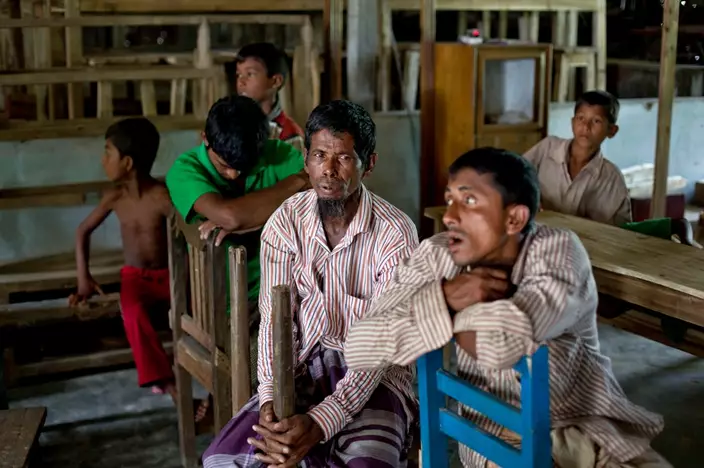
In this Sept. 30, 2017 photo, Rohingya survivors of a boat capsize, Sona Mia, center, and Lalo Mia, right, sit in a room to meet administration officers at Kutupalong camp for newly arrived Rohingya refugees in Bangladesh. Lalo's wife, a son and a daughter drowned when the fishing boat they were traveling in while fleeing from Myanmar capsized on Sept. 28. Of the 80 refugees believed to have been on that boat, only 24 are known to have survived. (AP Photo/Gemunu Amarasinghe)
On the beach in Alel Than Kyaw, the massive scale of the exodus became apparent.
Thousands of refugees from other parts of Rakhine were already camped there, exhausted. Each family had a story to tell, of a village burned, a husband shot, a wife raped.
Makeshift tents were scattered across the beach, which was littered with trash and the abandoned clothes of those who preceded them. Dozens of soldiers wandered among the crowds, interrogating the men.
Jafar found a spot to sit, and Khatun rested her head on his shoulder while their children played in the sand.
In his stomach, Jafar could feel a huge knot. Just a few days earlier, he had owned land and a house and provided for his family. Now, all that was gone.
A few hours after nightfall, a dozen fishing boats suddenly appeared, their distinctive bows and sterns each curved upward like wooden bull horns. Jafar and his family jumped to their feet and rushed forward with the crowds.
The boatmen, from Bangladesh, told the refugees they had been sent by "your relatives" — Muslim nations — "to take you across the river."
One of them pointed at Jafar.
"How many?"
"Five."
The boatman counted off about 75 more people, including as many as 50 children, and told the adults they had to leave their luggage behind. Jafar tucked the gold he had given his wife as a dowry into a small plastic bottle cap, then wrapped her pink veil around it in a knot. He stuffed their cash and land deed into the other end.
They waded into the warm water and climbed inside a 20-foot-long boat with outer planks painted light blue with white trim.
They found a spot in the rear, and scrunched down together, the twins in their arms and Mohamed huddled between. They were pressed together body to body, knee to chest. The boat was packed.
Several refugees not among those chosen grabbed onto the bow, begging to be let aboard. A boatman shoved them away.
When the engine started and they pulled away, the sea was calm. A crescent moon hung in a clear sky.
Khatun squeezed Jafar's hand. It seemed as good a time as any to make the crossing.
The southern tip of Bangladesh was only about 10 kilometers (6 miles) away.
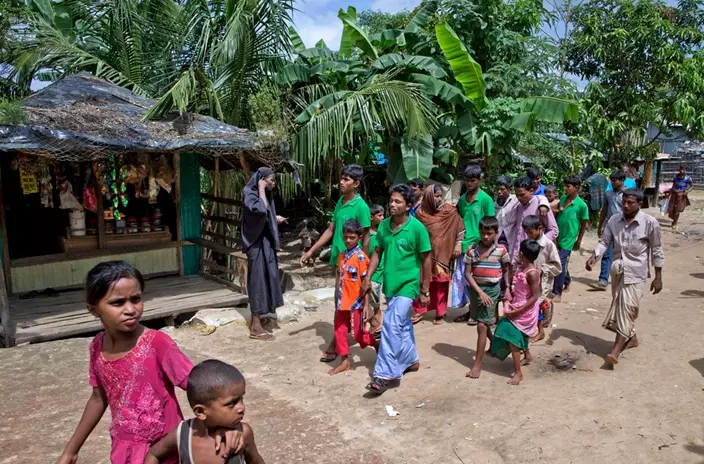
In this Sept. 30, 2017, photo, Rohingya refugee survivors of a Sept. 28 boat capsize walk in a group to a registration center at Kutupalong camp for newly arrived Rohingya refugees in Bangladesh. The boat capsized just 1,000 feet (300 meters) from shore, taking the lives of at least 50 people, most of them children, in the deadliest tragedy of its kind since the crisis exploded in late August. They were part of the largest human exodus in Asia since the Vietnam War, a colossal tide of more than 500,000 Rohingya Muslims whose homes had been torched by Buddhist mobs and soldiers. (AP Photo/Gemunu Amarasinghe)
At first no one spoke. The only sound was that of waves crashing against the boat's wooden hull, and wind whipping across its bow.
Jafar kept checking his watch.
One hour passed. Then two.
By then, he knew they should have arrived. But when he raised his head to peek over the edge, there was nothing to see but darkness.
"Mazi, what are you doing?" a passenger called out, using the local word for boatman. "Why aren't we there?"
"Shut up, you illiterate," one of the boatmen shot back. "Do you know how to steer this thing better than me?"
Jafar was not worried. He thought they might have taken a longer route to avoid Bangladeshi naval patrols or border guards ashore.
Over the next few hours, though, the weather grew steadily worse. Clouds began to obscure the stars. The wind began to pick up. And the air, once hot and sticky, grew chilly.
One by one, the refugees began to notice that the water, which had no perceptible scent at the mouth of the river, now smelled bitter. It was saltwater. Something had gone terribly wrong. They were at sea.
As the waves grew, small children began throwing up. Then the adults, vomiting into their clothes and cupped hands. Jafar felt ill.
When someone asked the mazi how much further they had to go, the response was blunt, emotionless.
"I don't know," the boatman replied, staring ahead into the night. "We're lost."
The comment set off a panic among the refugees, who began praying to God, to Allah. They had strayed far off course, deep into the ocean. The boatmen never explained how.
Steeper waves began battering the boat, splashing cold water inside. Children screamed.
"Oh my brother," one of the refugees, Rasheda Begum, begged a boatman. "Please take us to any village. Be it a Muslim or a Buddhist village. Just take us to land."
In the darkness, while Mohamed slept, Jafar could hear his wife weeping. He wrapped his arm around her. "Please don't worry," he told her. "Please don't."
As the night wore on, it took on a terrifying presence all around them. They could see nothing else.
After a few hours, someone spotted the twinkling lights of a large ship cruising slowly in the distance. They waved scarves above their heads and shouted across the waves.
Thirty minutes later, the lights had faded away.
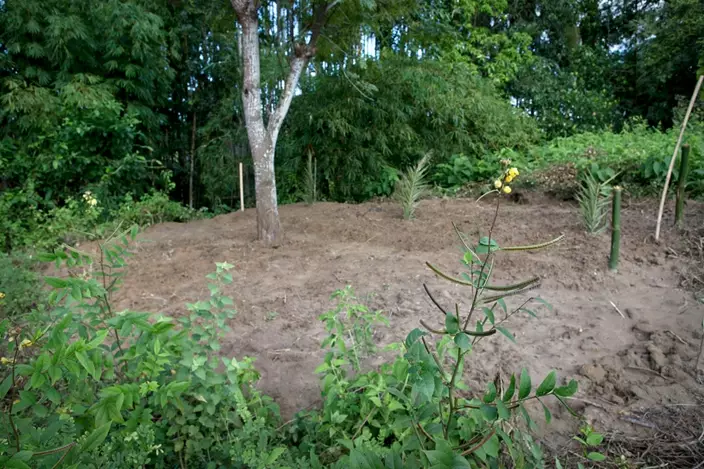
In this Oct. 1, 2017, photo, palm fronds stand in the dirt at a mass grave where Rohingya refugee victims of a Sept. 28 boat capsize lay buried in Ghunarmur Shikderpara, Cox's Bazar, Bangladesh. The boat capsized just 1,000 feet (300 meters) from shore, taking the lives of at least 50 people, most of them children, in the deadliest tragedy of its kind since the crisis exploded in late August. The mass grave lies in a clearing in a small coastal village lined with coconut trees and rice paddies. There are no names. (AP Photo/Gemunu Amarasinghe)
At dawn, a new feeling of dread set in.
All they could see, said another refugee called Malika, was "water, water, water."
There was no land in sight.
"We thought at that moment we were going to die," said Malika, who only uses one name. "Children were crying, hugging their fathers and their mothers. Everyone prayed."
Jafar's wife turned angrily to her husband, fighting back tears again.
"How could you do this to us? Why?" she said.
Jafar said nothing, and Khatun went on: "They're burning our villages. They're torturing our people. But this — this is even worse. The ocean is going to kill us all."
"This wasn't a mistake," Jafar said. "Maybe we will die here, but right now we are alive."
Sunrise brought one small ray of hope. It pointed the way east, which meant the coast of Bangladesh — had to be in the same direction.
By then, though, two of the boat's four plastic fuel drums were almost empty. And the crew had begun scooping water off the floorboards.
Soon, the mazis made a grim announcement: the boat was dangerously overloaded.
When they began grabbing small bags and bottles the refugees held in their laps and hurled them overboard, fights broke out.
"We begged them not to do it. We told them we need food and water for our kids, that these things aren't heavy," said Lalu Mia, who was traveling with his wife and five children.
Some thought the boatmen were trying to seize valuables and jewelry. When one man, Mohamed Kasim, resisted, a mazi queried him angrily.
"Is this more important than your life? You have to decide. Do you want to keep this, or do you want to survive?"
Jafar didn't struggle when the water bottle and biscuits he was holding were ejected into the sea.
His family's valuables, he knew, were tucked safely inside Khatun's scarf.
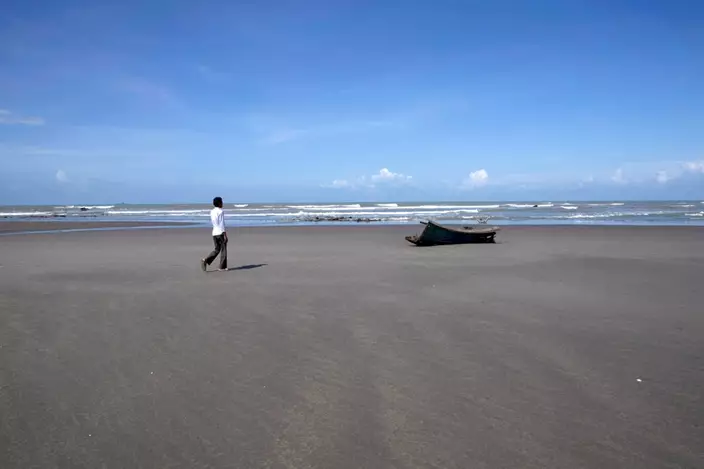
In this Oct. 30, 2017, photo, Ahamed Hossain, an eye witness and a first-responder of a Sept. 28 boat capsize that killed Rohingya refugees, walks towards a portion of what remains of the wooden boat at Inani beach in Cox's bazar, Bangladesh. The boat capsized just 1,000 feet (300 meters) from shore, taking the lives of at least 50 people, most of them children, in the deadliest tragedy of its kind since the crisis exploded in late August. They were part of the largest human exodus in Asia since the Vietnam War, a colossal tide of more than 500,000 Rohingya Muslims whose homes had been torched by Buddhist mobs and soldiers. (AP Photo/Gemunu Amarasinghe)
For what felt like an eternity, the boat sailed on. The stench of puke mixed with the smell of sweat and urine. There was so little room to move, some children relieved themselves under their clothes.
The lack of water made Jafar's throat yearn for it. His stomach grumbled.
When his son asked for a drink, he told Mohamed to wait — it would not be much longer. In whispers, though, he and his wife began to discuss the unthinkable.
"Please forgive me," Khatun said, "if I ever did anything wrong to you."
As the boat rocked endlessly back and forth, they drifted in and out of sleep. And then they were startled to hear one of the mazis, wide-eyed, yelling.
"It's there! It's there!"
Jafar thought he was dreaming. But when he lifted his cramped body up he saw it, too: the top of a green hill peeking out of white clouds on a coast.
No one knew what country it was.
No one cared.
For the first time since they fled their village, Jafar saw people smile. Their two-hour trip turned into 18 might finally be about to end.
His wife squeezed their children.
"Oh, blessed Allah, he knows where we are," Khatun said. "Maybe we will be OK. Maybe we will get there."
As the boat motored toward the shore, though, the wind began to pick up again. The sky darkened. Torrential sheets of rain began to fall.
And then, somewhere around 3:30 p.m., the engine died.
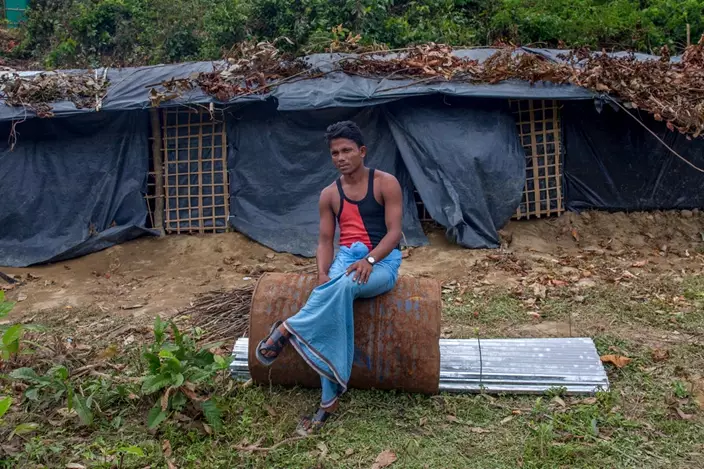
In this Oct. 19, 2017, photo, a Rohingya Muslim man Alam Jafar, who crossed over from Myanmar into Bangladesh, sits for a photograph outside his shelter in Thaingkhali refugee camp, Bangladesh, Cox's Bazar. In Myanmar, the 25-year-old farmer owned a verdant rice field, a boat that ferried passengers up and down the river and lived in a four-room house made of wood and bamboo surrounded by coconut and mango trees. When the mob came to his village on Sept. 25, Jafar had no choice but to flee with his wife and three children. On Sept. 28, the small fishing boat they were traveling in capsized while it was bound for Bangladesh and left him as the sole survivor of the family of 5. (AP Photo/Dar Yasin)
Standing in front of his store on Inani Beach, shopkeeper Ahmed Hossain saw what he thought was a fishing boat emerge from the storm.
He knew it shouldn't have been there. The monsoon battering the coast was so large and powerful, it had already shut down the airport at Cox's Bazar, 30 kilometers (20 miles) to the north.
Out on the boat, the refugees didn't know if they had run out of fuel, or if the engine had broken down.
As one of the mazis yanked the engine cord repeatedly, people began reciting final prayers and crying out.
"Please Allah! Please save us!"
The desperation angered the crew, and they shouted at the refugees.
"Shut up! Shut up! Stop it!"
Without power, the boat was at the mercy of the waves, which tossed it around like a toy. Although the shoreline was just a few hundred yards (meters) away, most of the children aboard did not know how to swim.
The boat drifted into a precarious position: perpendicular to the waves, which were now tipping it perilously back and forth.
When the giant wave hit, it thrust the boat upside down. It threw Jafar into the surging ocean with the twins, who were wrapped around his chest in a longyi.
Arms thrashing, he surfaced, trying to keep their heads above water. He could barely see, but he spotted his wife, and his son. He heard Mohamed crying out.
"Papa! Papa! Help Me!"
"Papaaaaa."
They were not far away, maybe 10 feet, when the second wave crashed down. He lost sight of them as the swirling ocean carried him away.
For half an hour, Jafar struggled to swim on his back in the current. But the waves and the weight of the twins kept pushing him down. He didn't know if they were dead.
He was exhausted. When he realized he would drown if he held on to them any longer, he untied the longyi, and let go of his babies.
By the time he crawled onto the beach and collapsed, it was twilight. A stranger rushed forward and knelt beside him, asking if he was OK.
"Where am I?" Jafar asked weakly.
"Brother," the man said. "You are in Bangladesh."

In this Oct. 19, 2017, photo, a Rohingya Muslim man Alam Jafar, who crossed over from Myanmar into Bangladesh, sits for a photograph outside his shelter in Thaingkhali refugee camp, Bangladesh, Cox's Bazar. In Myanmar, the 25-year-old farmer owned a verdant rice field, a boat that ferried passengers up and down the river and lived in a four-room house made of wood and bamboo surrounded by coconut and mango trees. When the mob came to his village on Sept. 25, Jafar had no choice but to flee with his wife and three children. On Sept. 28, the small fishing boat they were traveling in capsized while it was bound for Bangladesh and left him as the sole survivor of the family of 5. (AP Photo/Dar Yasin)
That night, Jafar searched desperately for Khatun and Mohamed and the twins.
When he found their bodies, laid out on the sand by rescuers, he broke down and wept.
He says he can barely remember any more about that moment. He can hardly even speak of it.
Of the 80 refugees believed to have been on the boat when it capsized on Sept. 28, only 24 are known to have survived.
Police collected 23 corpses from the shore. The rest — mostly children — are missing and presumed to have drowned. It is not known what happened to the crew.
Khatun's scarf, with the gold, money and land deed, was never found.
It is two weeks after the disaster, and Jafar is slicing bamboo poles to build a shelter on the edge of a new refugee camp.
His older brother, who was also on the boat, is beside him. But he cannot bear to be here without his own family.
Sleep brings nightmares. Daylight brings ghosts.
"Wherever I look, I see my kids," he says. "I see my eldest child every day. He comes and sits in front of me, even now."
Jafar can't stop thinking about what happened. He feels helpless, overcome with guilt.
"Why did I bring my children here and let them die in the water?" he asks. "Wouldn't it have been nice if I, too, had died? Wouldn't it?"
The mass grave where his wife and children are buried is not far away.
It lies in a clearing in a small coastal village lined with coconut trees and rice paddies.
There are no names. Just a trio of palm fronds stuck in the dirt like tombstones.
From there, it's a short walk to the place where the doomed boat washed ashore the night it capsized. It was ripped in half.
Two weeks later, nothing is left. Even the smallest wooden planks have been dragged away by the tides.



